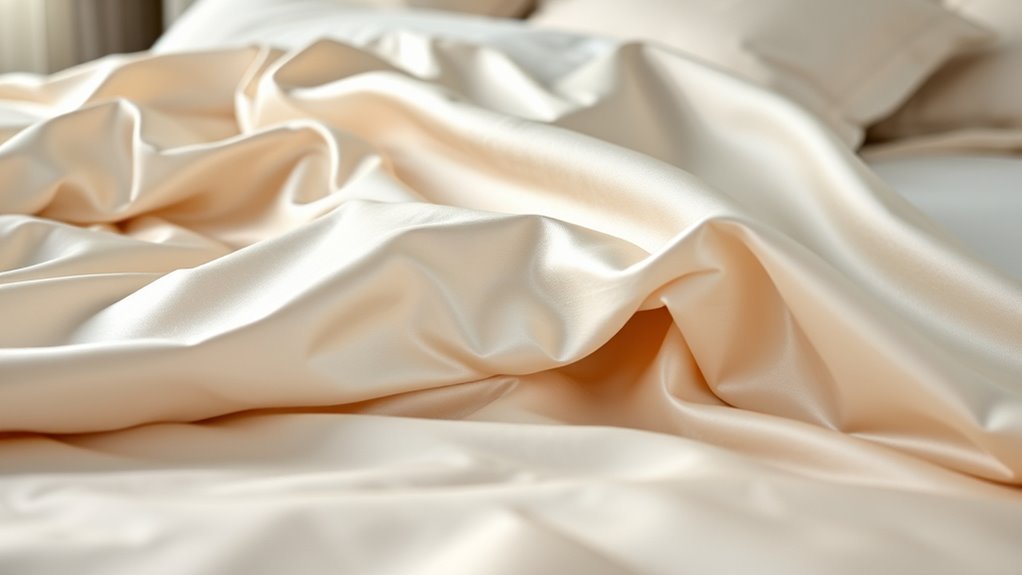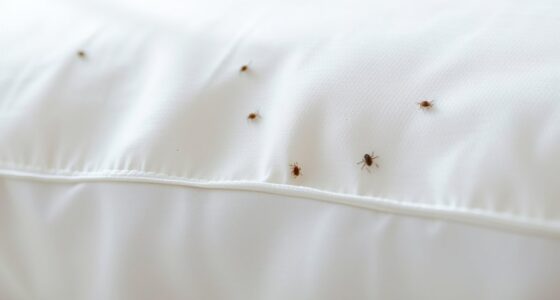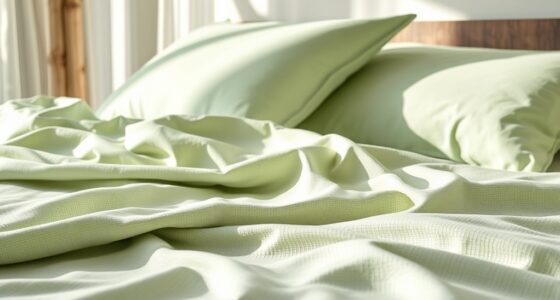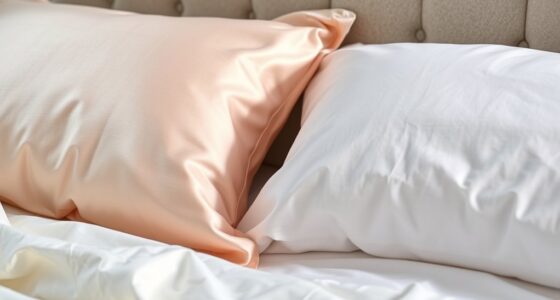Satin sheets are more durable and easier to care for than silk, making them a practical choice for everyday use. They resist tears, fraying, and snags better, and are often machine washable, saving you time and effort. While silk offers a luxurious, natural feel, it requires delicate handling and higher maintenance. If you want a balance of longevity and elegance, satin might suit your needs better—keep exploring to discover more about each option.
Key Takeaways
- Satin sheets are more durable and resistant to snags, tears, and fraying compared to delicate silk sheets.
- Satin offers a similar luxurious appearance and softness at a lower cost than genuine silk.
- Satin is easier to care for, typically machine washable, and requires less delicate handling than silk.
- Silk is naturally breathable and ages beautifully when properly maintained, while satin’s synthetic fibers can be more resilient.
- Satin sheets are a budget-friendly, low-maintenance alternative suitable for everyday use.
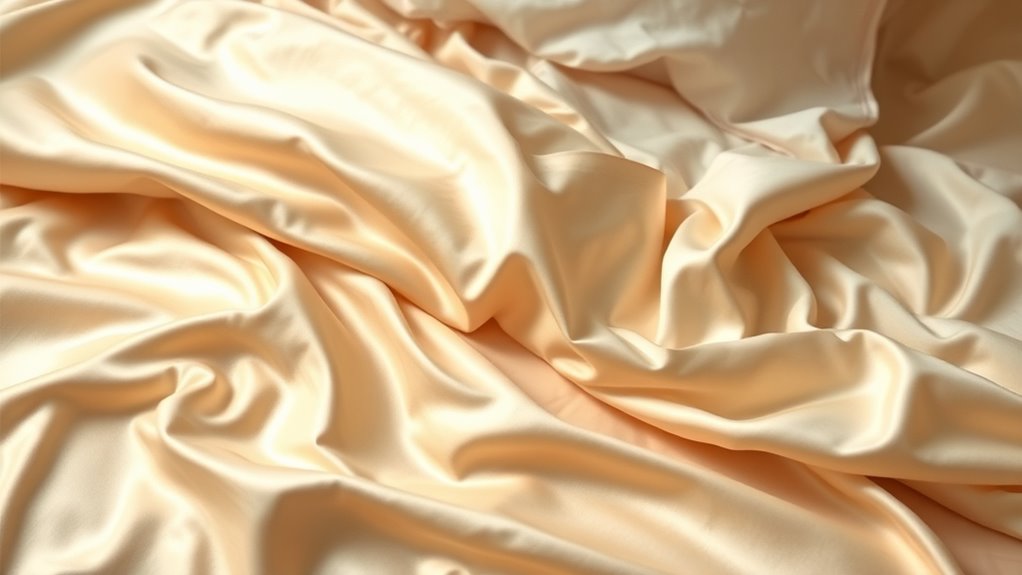
When choosing between satin and silk sheets, understanding their unique benefits can help you make an informed decision. One of the key factors to weigh is durability. Silk, being a natural fiber, is incredibly delicate and requires careful handling to prevent tears or fraying. Over time, silk sheets may show signs of wear, especially if you wash them frequently or don’t follow proper care instructions. proper care is essential to maintain their luxurious feel and longevity. Satin, on the other hand, often has a durability comparison that favors it slightly. Since many satin sheets are made from synthetic fibers like polyester, they tend to withstand washing and everyday use better than silk. This means they’re less likely to develop snags or frays over time, making them a more resilient choice if you’re looking for longevity. However, keep in mind that the quality of satin varies considerably based on the material and craftsmanship, so a well-made satin sheet can still last for many years.
Cost analysis is another important aspect you should evaluate. Silk sheets generally come with a higher price tag because silk is a luxurious, natural material that requires meticulous processing. The cost of genuine silk sheets can be substantial, and that investment often reflects their premium feel and natural properties. Satin sheets, especially those made from synthetic fibers, tend to be much more affordable. They provide a similar sleek, shiny appearance and soft touch at a fraction of the price, making them an attractive option for budget-conscious shoppers. If you’re seeking a luxurious feel without the hefty cost, satin can offer an excellent alternative. However, if authenticity and natural fibers are non-negotiable for your comfort or ethical reasons, then the higher cost of silk might be justified.
Both options have their own advantages in terms of maintenance. Silk requires gentle washing and careful handling to preserve its delicate fibers, which can add to ongoing costs and effort. Satin sheets are usually easier to care for; many are machine washable and more resistant to everyday wear and tear. When deciding between the two, consider how much time and money you’re willing to invest in upkeep. If you prefer low maintenance and durability, satin might be the better choice. But if you prioritize natural materials and a softer, more breathable fabric that ages beautifully with proper care, silk could be worth the investment despite its higher initial cost. Ultimately, your choice will depend on your budget, lifestyle, and personal preferences about how much longevity and natural luxury matter to you.
Frequently Asked Questions
How Do Satin and Silk Sheets Compare in Allergen Resistance?
When comparing satin and silk sheets for allergen resistance, you’ll find that both have hypoallergenic properties, making them good options for sensitive skin. Silk naturally resists dust mites and mold, offering strong allergen resistance. Satin, especially when made from synthetic fibers, can also be hypoallergenic but may trap more allergens if not properly maintained. Your choice depends on the allergen resistance comparison and your preference for natural versus synthetic materials.
Are Satin Sheets More Durable Than Silk Over Time?
You might wonder if satin sheets are more durable than silk over time. In a durability comparison, satin often holds up better against long term wear because of its tightly woven fibers and synthetic materials, making it less prone to tearing or fraying. Silk, while luxurious, tends to be more delicate and can show signs of wear more quickly. So, if longevity matters, satin generally offers a more durable option.
Which Material Is Better for Sensitive Skin?
When choosing sheets for sensitive skin, you consider skin irritation and hypoallergenic qualities. Satin sheets, often made from synthetic fibers, can sometimes cause irritation, especially if you have allergies. Silk, naturally hypoallergenic and gentle, minimizes skin irritation and reduces allergy risks. So, if you want to protect sensitive skin, silk sheets are generally a better choice because they’re soft, breathable, and less likely to trigger allergic reactions.
How Do Maintenance and Cleaning Differ Between Satin and Silk?
Imagine your sheets throwing a tantrum every time you try to wash them—satin and silk aren’t that different. You’ll need gentle washing instructions, like hand washing or using delicate cycles, to avoid damage. Stain removal requires patience; avoid harsh chemicals. Silk demands more care, with dry cleaning often recommended, while satin is a bit more forgiving. So, get ready for some laundry love or hate, depending on your patience!
Do Satin and Silk Sheets Have Different Environmental Impacts?
When comparing satin and silk sheets, you’ll find their eco-friendliness varies. Satin, often made from polyester, has a higher production environmental impact due to synthetic material use and energy consumption. Silk, a natural fiber, generally has a lower environmental footprint but involves more resource-intensive farming and processing. So, if you prioritize eco-friendliness, silk tends to be the better choice, though production methods for both influence their overall environmental impact.
Conclusion
Choosing between satin and silk sheets is like picking your favorite star in the night sky—each offers its own shimmering charm. Satin wraps you in sleek, smooth comfort, while silk whispers luxury with every touch. Whichever you choose, you’re inviting a touch of elegance and serenity into your nights. So, embrace the silky allure that calls to you, and let your sleep become a luxurious escape where dreams glide on a cloud of shimmering comfort.
